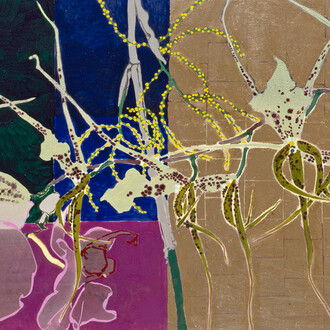Recline emphasizes Matisse’s mastery and frequent use of the medium of printmaking as an extension of drawing. Nearly 20 prints, spanning the first half of the 20th century, range from the detailed lithograph of an odalisque set in an ornate interior to the simplified line work of almost abstract aquatint portraits. In returning to the female form and endlessly adapting his approach, Matisse continuously sought to capture the essence of his subject.
In many pieces, and throughout his career, Matisse paid as much attention to the setting as he did the figure, with an emphasis on patterning, furniture, and decorative elements. A William N. Copley canvas lovingly layers Matisse-like pattern on pattern in a bedroom scene replete with a shapely ceramic pitcher, chevron wallpaper, and a plaid coverlet. Recline pays homage to Matisse’s reverence of interior architecture and beloved objects in his studio by incorporating several contemporary domestic items. The materiality of these sculptural works, from Mattia Bonetti’s graceful yet whimsically festooned Garden Loveseat to Ron Arad’s curvaceous Big Easy chair, further engages our concept of contour and line through physical form. In Matisse's more reductive drawings, there are similarly playful moments that happen between a straight line and the freedom of an effortless curve.
Portraiture is as infinitely versatile as its sitter; it can entail a certain intimacy and summon the narrative aspect of storytelling. Tal R channels Matisse in a beautiful portfolio of twelve etchings depicting nude smokers set into confined interiors. Rendered in tones from flesh to rose, the detailed settings at times appear to swallow up the defiant subjects. Their casually held cigarettes perhaps a slight nod to early 20th century European café culture, evoke a temporal relationship between the artist and his model. Tom Wesselmann, known mostly for his lounging female nudes (or isolating parts of those nudes), constructs a larger-than-life interior depicting the face of a blonde woman framed by the cropped edge of a table lamp, the corner of a drape flapping in front of an open window, and lush lavender irises in the foreground. The stencil-like outlines anticipate the sharp delineation of his “steel drawings” made in the mid-1990s.
Elizabeth Peyton and David Hockney’s tender portraits reveal a romantic intent to capture the spirit and the will of the sitter. In contrast to the repetitious work of depicting a nude, and using it to formalistic ends, there is a marked difference between a subject explored and a subject used as a compositional device or framework. A John Wesley painting of a sofa depicts a nude woman lying between a pair of pillows – all of which flatten out to become one with the sofa’s upholstery. Wesley blurs the line between the object and objectified, the sitter and seat. In Katie Stout’s Narcissus Mirror two pulpy female figures hold up an irregularly shaped mirror between their backsides – asking us to reflect on their nudity, their fleshy cartoon-ness, our gaze, and for a moment, ourselves. Elizaveta Shneyderman writes in a March 2018 Artforum review “...Stout’s works subvert the space of the domestic, renouncing stale notions of beauty that take the female form as a given. Buxom caricatures stand in as furniture, their eroticisms flashing like epithets to their own mislabeling. These static pantomimes thumb their noses at tradition.”
The rich lineage of portraiture and the volume of objects, easily anthropomorphized as stand-ins for human figures, keep good company. The exhibition concludes in a room with several portraits washed in the pink glow of a Tracy Emin neon work: The Memory of Your Touch, 2017.
















